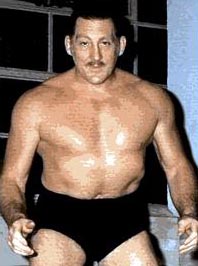
Frank Alvin Gotch was an American professional wrestler. Gotch was the first American professional wrestler to win the world heavyweight free-style championship, and he is credited for popularizing professional wrestling in the United States. He competed back when the contests at championship level were largely legit, and his reign as World Heavyweight Wrestling Champion is one of the ten longest in the history of professional wrestling. He became one of the most popular athletes in America from the 1900s to the 1910s. Pro Wrestling Illustrated described Gotch as "arguably the best North American professional wrestler of the 20th century".

Georg Karl Julius Hackenschmidt was an Estonian strongman, professional wrestler, writer, and sports philosopher who is recognized as professional wrestling's first world heavyweight champion.

Aloysius Martin Thesz, known by the ring name Lou Thesz, was an American professional wrestler. Considered to be one of the last true shooters in professional wrestling and described as the "quintessential athlete" and a "polished warrior who could break a man in two if pushed the wrong way", Thesz is widely regarded as one of the greatest wrestlers and wrestling world champions in history, and possibly the last globally accepted world champion.

Stanisław Jan Cyganiewicz, better known by his ring name Stanislaus Zbyszko, and frequently referred to in the contemporary English-language press as Zbysco, was a Polish strongman and professional wrestler. He was a three-time World Heavyweight Champion in the United States during the 1920s. The surname Zbyszko was a nickname given to him by friends due to his bravery as a child. The name originates from a fictional medieval Polish knight in the historical novel The Knights of the Cross by Henryk Sienkiewicz, published in 1900. Stanislaus Zbyszko was the brother of Wladek Zbyszko (1891–1968).

Mitsuyo Maeda naturalized as Otávio Maeda, was a Japanese-born Brazilian judōka and prizefighter in no holds barred competitions. He was known as Count Combat or Conde Koma in Spanish and Portuguese, a nickname he picked up in Spain in 1908. Along with Antônio Soshihiro Satake, he pioneered judo in Brazil, the United Kingdom, and other countries.
Shoot wrestling is a Japanese hybrid grappling style and combat sport. Shoot wrestling incorporates techniques from various wrestling, submission grappling, kickboxing and karate styles. It was particularly inspired and influenced by catch wrestling, a form of wrestling with submissions that was the predominant style of professional wrestling in the 19th and early 20th century, at the time a competitive sport and not yet predetermined.

Karel Istaz, best known by his ring name Karl Gotch, was a Belgian professional wrestler, amateur wrestler, catch wrestler, and trainer.

Jatindra Charan Guha, popularly known by his ring name Gobar Guha, was an Indian professional wrestler trained in pehlwani wrestling. Guha spent most of his career wrestling internationally, defeating champion wrestlers Wladek Zbyszko, Renato Gardini, Ad Santel, and Joe Stecher. By defeating Santel, he became the first Asian to win a World Wrestling Championship in the United States.

Catch wrestling is a style of wrestling with looser rules than forms like Greco-Roman wrestling. For example, catch wrestling allows leg attacks and joint locks. It was popularised by wrestlers of travelling funfairs who developed their own submission holds, referred as "hooks" and "stretches", into their wrestling to increase their effectiveness against their opponents.

An undisputed championship is a professional wrestling term for a world title that is the unquestioned top championship in a promotion, often formed from two world titles being unified or held by the same individual.

Taro Miyake was a professional Japanese jujutsu fighter, instructor, catch wrestler and author. Protege of the legendary ground-fighter Mataemon “Newaza” Tanabe, he is credited with helping establish jujutsu and MMA in the United Kingdom, France and the United States at the start of the 20th century.

Peter Sauer, was an American professional wrestler, better known by the ring name Ray Steele. He was born and raised in Norka, a German colony in Russia, in 1900 before immigrating to Lincoln, Nebraska, in 1906. A highly skilled and dangerous catch wrestler, Steele was known for his extensive knowledge of submission holds.

Ivan GeneLeBell was an American judoka, stuntman, actor and professional wrestler. He worked on over 1,000 films and TV shows and authored 12 books.

Joe Stecher, sometimes spelled Joe Stetcher, was an American professional wrestler and three-time World Heavyweight Wrestling Champion. Known for his ferocity, tremendous leg strength and extensive knowledge of the sport, Stecher is considered to be one of the greatest wrestlers of all time. In 2000, Stecher was inducted into the George Tragos/Lou Thesz Professional Wrestling Hall of Fame.

The history of professional wrestling, as a performing art, started in the late 19th century, with predecessors in funfair and variety strongman and wrestling performances in the 1830s.

The World Heavyweight Wrestling Championship was the first recognized professional wrestling world heavyweight championship created in 1905 to identify the best catch as catch can wrestler in the world.
Antonio Satake, born Soshihiro Satake, was a Japanese-born Brazilian martial artist and teacher. One of the teachers of Brazilian martial artist Luiz França, together with Geo Omori and Mitsuyo Maeda, Satake was one of the primary founders of Brazilian jiu-jitsu (BJJ). He pioneered judo in Brazil, the United Kingdom, and other countries.

Tokugoro Ito was a Japanese judoka and professional wrestler. Ito was one of the founding fathers of mixed martial arts in Brazil.

Kiyoshi Noguchi, also known as Senryuken Noguchi was a Japanese martial artist. He was the founder of the Shinto Rokugo-ryū and Shinto Fuso-ryū schools of martial arts, as well as a scholar and popularizer of jujutsu through mail order marketing.

















